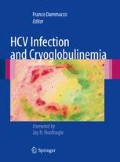Abstract
Mixed cryoglobulinemia (MC) is a relatively rare disorder that may complicate numerous infectious or immuno/hematological diseases. Classical MC syndrome is associated with hepatitis C virus (HCV) infection in the large majority of patients and the virus is suspected in the etiopathogenesis of the disease. MC syndrome, or cryoglobulinemic vasculitis, is characterized by a clinical triad of purpura, weakness, and arthralgias and by variable organ and, in many cases, endocrine involvement. As a late complication, some patients develop malignancies, particularly B-cell lymphomas and/or hepatocellular carcinoma. To date, there are no available diagnostic criteria for MC, but classification criteria must account for its serological and clinical hallmarks. Leukocytoclastic vasculitis, especially of the small blood vessels, is the typical pathological finding of affected tissues. An important pathogenetic step in MC is HCV lymphotropism, which is responsible for poly/oligoclonal B-lymphocyte expansion. The consequence is a wide production of different autoantibodies and immune complexes, mainly cryoglobulins, responsible for organ- and non-organ-specific immunological alterations. Thus, MC, characterized by the simultaneous presence of autoimmune and lymphoproliferative diseases, is the crossroads of these disorders and represents the prototype of HCV-associated pathologies. The oncogenic potential of HCV is demonstrated by several studies showing its pathogenetic link with some malignancies, particularly the hepatocellular carcinoma and B-cell lymphomas. HCV-related disorders have a heterogeneous geographical distribution, suggesting other important genetic and/or environmental co-factors. Although the majority of individuals with chronic HCV infection exhibit hepatic manifestations only or are totally asymptomatic, a not negligible percentage develop autoimmune and/or lymphoproliferative/neoplastic disorders through a multifactorial and multistep pathogenetic process, reflected by the name “HCV syndrome.”
Access this chapter
Tax calculation will be finalised at checkout
Purchases are for personal use only
References
Ferri C (2008) Mixed cryoglobulinemia. Orphanet J Rare Dis 16(3):25, http://www.ojrd.com/content/3/1/25
Ferri C, Sebastiani M, Giuggioli D et al (2004) Mixed cryoglobulinemia: demographic, clinical, and serologic features and survival in 231 patients. Semin Arthritis Rheum 33:355–374
Dammacco F, Sansonno D (1997) Mixed cryoglobulinemia as a model of systemic vasculitis. Clin Rev Allergy Immunol 15:97–119
Ferri C, Monti M, La Civita L et al (1994) Hepatitis C virus infection in non-Hodgkin’s B-cell lymphoma complicating mixed cryoglobulinaemia. Eur J Clin Invest 24:781–784
Ferri C, Antonelli A, Mascia MT et al (2007) HCV-related autoimmune and neoplastic disorders: the HCV syndrome. Dig Liver Dis 39:S13–S21
Zignego AL, Macchia D, Monti M et al (1992) Infection of peripheral mononuclear blood cells by hepatitis C virus. J Hepatol 15:382–386
Ferri C, Monti M, La Civita L et al (1993) Infection of peripheral blood mononuclear cells by hepatitis C virus in mixed cryoglobulinemia. Blood 82:3701–3704
Zignego AL, Ferri C, Pileri SA, et al for the Italian Association of the Study of Liver (AISF) (2007) Commission on Extrahepatic Manifestations of HCV infection. Extrahepatic manifestations of hepatitis C virus infection: a general overview and guidelines for a clinical approach. Dig Liver Dis 39:2–17
Zignego AL, Ferri C, Giannelli F et al (2002) Prevalence of Bcl-2 rearrangement in hepatitis C virus-related mixed cryoglobulinemia with or without complicating B-cell lymphoma. Ann Intern Med 137:571–580
Ramos-Casals M, De Vita S, Tzioufas A (2005) Hepatitis C virus, Sjogren’s syndrome and B-cell lymphoma: linking infection, autoimmunity and cancer. Autoimmun Rev 4:8–15
Agnello V, De Rosa FG (2004) Extrahepatic disease manifestations of HCV infection: some current issues. J Hepatol 40:341–352
Dammacco F, Lauletta G, Montrone M, Sansonno D (2007) Mixed cryoglobulinemia: a model of virus-related disease in internal medicine. Dig Liver Dis 39:S8–S12
Antonelli A, Ferri C, Fallahi R et al (2004) Thyroid involvement in patients with overt HCV-related mixed cryoglobulinaemia. QJM 97:499–506
Antonelli A, Ferri C, Ferrari SM et al (2008) Immunopathogenesis of HCV-related endocrine manifestations in chronic hepatitis and mixed cryoglobuliemia. Autoimmun Rev 8:18–23
Monti G, Pioltelli R, Saccardo E et al (2005) Incidence and characteristics of non-Hodgkin lymphomas in a multicenter case file of patients with hepatitis C virus-related symptomatic mixed cryoglobulinemias. Arch Intern Med 165:101–105
Antonelli A, Ferri C, Fallahi R (1999) Thyroid cancer in patients with hepatitis C infection. JAMA 281:1588
Ferri C, Mascia MT, Saadoun D, Cacoub P (2009) Cryoglobulinemia and systemic manifestations of hepatitis C virus. EULAR compendium on rheumatic diseases, Ed. BMJ Publishing Group Ltd, London. Chap. 42a accessed on May 1 2009
Matsumori A (2005) Hepatitis C virus infection and cardiomyopathies. Circ Res 96:144–147
Author information
Authors and Affiliations
Corresponding author
Editor information
Editors and Affiliations
Rights and permissions
Copyright information
© 2012 Springer-Verlag Italia
About this chapter
Cite this chapter
Ferri, C., Antonelli, A., Sebastiani, M., Colaci, M., Zignego, A.L. (2012). The Expanding Spectrum of Clinical Features in HCV-Related Mixed Cryoglobulinemia. In: Dammacco, F. (eds) HCV Infection and Cryoglobulinemia. Springer, Milano. https://doi.org/10.1007/978-88-470-1705-4_19
Download citation
DOI: https://doi.org/10.1007/978-88-470-1705-4_19
Published:
Publisher Name: Springer, Milano
Print ISBN: 978-88-470-1704-7
Online ISBN: 978-88-470-1705-4
eBook Packages: MedicineMedicine (R0)

